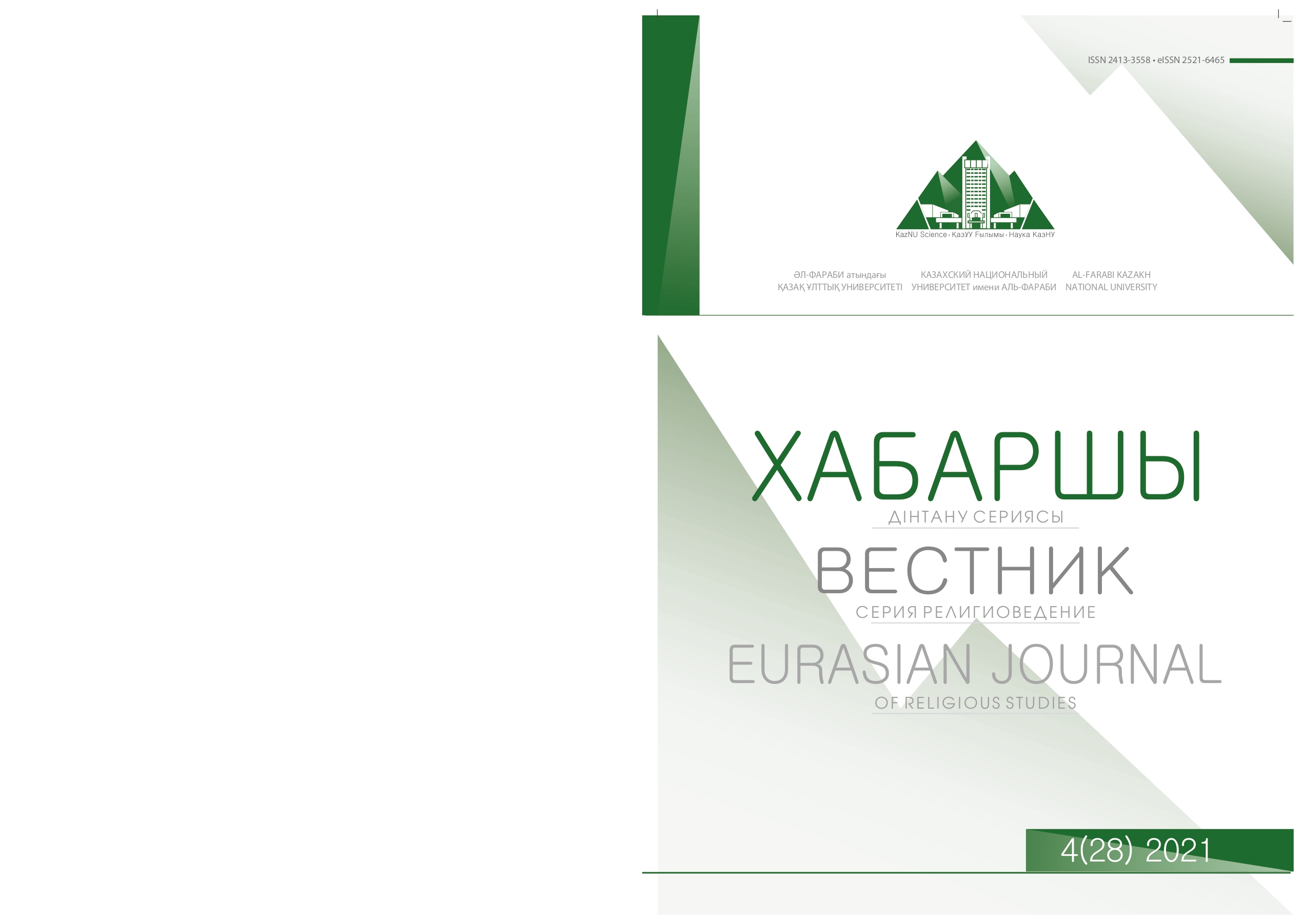Проявление тюркского мировоззрения в произведении «Иршад ал-мулуук ва ас-салатиин»
Түркі дүниетанымы
DOI:
https://doi.org/10.26577//EJRS.2021.v28.i4.r6Ключевые слова:
тюрки, средневековое тюркское мировоззрение, исламская культура, мамлюки, тюркский языкАннотация
В статье рассматриваются проявления средневекового тюркского мировоззрения и культуры, их непосредственное влияние как на исламский мир так и духовной культуры того периода и их жизнеспособность. К власти в исламском мире пришли тюркские кипчаки, известные на исторической арене как мамлюки (тюркского происхождения). С тех пор тюркский язык (древнекипчакский язык) занимает особое место в обществе исламского мира. Обсуждаются не только языковые особенности тюрков на кыпчакском языке, но и религиозная направленность литературных произведений написанных на арабском языке, и умение переводить классическую литературу на тюркский язык. Обсуждается, что произведение «Иршад ал-Мулюк ва ас-Салатиин», написанное в 14 веке и содержащее значительное количество основных элементов кыпчакского языка (тюркского языка), было одним из самых важных произведений в истории тюркского мировоззрения, тюркского языка и литературы. Установлено, что это произведение написано на кипчакском языке по приказу султана Сайфи Баймана в Александрии, проводится герменевтический и текстологический анализ текстов рукописа. Рукопись также считается одной из самых ранних письменных кипчакских надписей в Египте.
Ключевые слова: тюрки, средневековое тюркское мировоззрение, исламская культура, мамлюки, тюркский язык.
Библиографические ссылки
Brockelmann, C. (1898)GAL, Geschichte der arabishen Litteratur. – Berlin. В.І. – 1072.
CericM. (1995) Roots of Synthetic Theology in Islam. A study of the Theology of Abu Mansur al-Maturidi. – Kuala Lumpur: ISTAC. – 456.
Ibn el-Fakih (1885). Kitab el-Buldan. De Goeje. – Leyden: Elzeviriana. – 398.
Islam Ansiklopedisi (2020). – Ankara: TDV Yayınları / İSAM Yayınları.– 529.
Kafkasyalı M. S. (2013) Milli Akıl ve Türk-İslâm Düşüncesindeki Yeri. Hoca Ahmet Yesevi Uluslararası Türk Kazak Üniversitesi. – Ankara-Türkistan. –214.
Kаvakçı Y. (1976) ХІ ve XII asırlarda Karahanıylar davrinde Mavara an-Nahr Islam Hukukçıları. – Ankara: Otto – 305.
Shalkarov D. (2014) Maturidi teolojisi ve ana kaynakları // Uluslararası İmam Maturidi Symposiumі. – Turkey: Eskişehir, 2014, аpril 28-30. –705-711.
Şeşen,Ramazan (1988) Ebû Osman Amr b. Bahr, Hilâfet Ordusunun Menkіbeleri ve Türkler’in Fazîletleri. – Ankara: Türk Kültürünü Araştırma Enstitüsü Yayınları. – 378.
Toparlı,Recep (1992).Irşadül mülük ve es-selatın.– Ankara: ATATÜRK kültür, dil ve tarıh yüksek kurumu, türk dil kurumu yayınları. – 627.
Van Ess J. (1970) The logіcal structure of Islamіc Theology. Logіc іn Classіcal Culture. Edіted by G. E. Von Grunebaum. – Otto Harrossowіtz. Р. – 50.
Yaşar Çağbayır. Bilge Kağan Yazıtı. Sevim Yörük-Yaşar Yörük. Açıklamalı Atasözleri Sözlüğü. – İstanbul: Serhat yayınları, 1996. – 293 s.
Сулаймон Косоний (1991) Урта Осиё тарихи. Т. ІІ. ІІІ. – Саудия Арабистони мамлакати: Дар-ал-Кутуб.– 360.
Факиһ, Берке (1385) «Иршәдул-мулук уәс-салатин» қолжазбасы. – Стамбул: Сулаймания кітапханасы, Аясофья бөлімі №1016. – 498.
References
Brockelmann, C. (1898). GAL, Geschichte der arabishen Litteratur [History of Arabic Literature]. –Berlin. В.І. – 1072. (in Germany)
Ceric M. (1995). Roots of Synthetic Theology in Islam. A study of the Theology of Abu Mansur al-Maturidi. – Kuala Lumpur: ISTAC. – 456.
Çağbayır, Yaşar (1996) Bilge Kağan Yazıtı. Sevim Yörük-Yaşar Yörük. Açıklamalı Atasözleri Sözlüğü. [Bilge Kagan Inscription. Annotated Dictionary of Proverbs]. – İstanbul: Serhat yayınları, 1996. – 293 s. (in Turkish)
Ibn el-Fakih (1885). Kitab el-Buldan [The book of countries]. De Goeje. – Leyden: Elzeviriana. – 398. (in Arabic)
Islam Ansiklopedisi (2020). [Islamic Encyclopedia]. – Ankara: TDV Yayınları / İSAM Yayınları. – 529.
Kafkasyalı M. S. (2013). Milli Akıl ve Türk-İslâm Düşüncesindeki Yeri [National Mind and Its Place in Turkish-Islamic Thought]. – Ankara-Türkistan: Hoca Ahmet Yesevi Uluslararası Türk Kazak Üniversitesi. – 214. (in Turkish)
Kаvakçı Y. (1976). ХІ ve XII asırlarda Karahanıylar davrinde Mavara an-Nahr Islam Hukukçıları [Mavara an-Nahr Islamic Lawyers in the ХІ and XII centuries under the Karakhanids]. – Ankara: Otto – 305. (in Turkish)
Shalkarov D. (2014). Maturidi teolojisi ve ana kaynakları // Uluslararası İmam Maturidi Symposiumі [Maturidi theology and its main sources // International Imam Maturidi Symposium]. – Turkey: Eskişehir, 2014, аpril 28-30. –705-711. (in Turkish)
Şeşen, Ramazan (1988). Ebû Osman Amr b. Bahr, Hilâfet Ordusunun Menkіbeleri ve Türkler’in Fazîletleri [The Legends of the Caliphate Army and the Virtues of the Turks]. – Ankara: Türk Kültürünü Araştırma Enstitüsü Yayınları. – 378. (in Turkish)
Toparlı, Recep (1992). Irşadül mülük ve es-selatın [Guiding thesultans]. – Ankara: ATATÜRKkültür, dilvetarıhyüksekkurumu, türkdilkurumuyayınları. – 627. (in Turkish)
Van Ess J. (1970). The logіcal structure of Islamіc Theology. Logіc іn Classіcal Culture. Edіted by G. E. Von Grunebaum. – Otto Harrossowіtz. – 50.
Косоний, Сулаймон (1991). УртаОсиётарихи [Central Asian history]. Т. ІІ. ІІІ. – СаудияАрабистонимамлакати: Дар-ал-Кутуб. – 360. (in Uzbek)
Факиһ, Берке (1385) «Иршәдул-мулукуәс-салатин» қолжазбасы [The manuscript of «Guiding the sultans» қолжазбасы]. – Стамбул: Сулайманиякітапханасы, Аясофьябөлімі №1016. – 498. (in Arabic)




